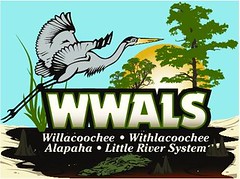This AJC op-ed is about coastal wetlands, but much of it applies to wetlands such as cypress swamps and streams in Lowndes County and the rest of central south Georgia, especially since our state water plan for the Suwannee-Satilla Region points us at County-Level Population Projections from the Governor’s Office of Planning and Budget that project 45% growth in Lowndes County population in 20 years to 156,650 people by 2030, which means near doubling in 30 years to 2050. -jsq
David Kyler wrote for the AJC 29 December 2006, “Plant the seeds for viable coastal future”,
Recent population projections for the Georgia coast issued by
Georgia Tech say nothing new. We’re growing at almost 20 percent a decade, meaning a near doubling every 35 years.
The Center for a Sustainable Coast projected a population of about 1 million by 2030 for the 11 counties in the coastal region as defined by the Department of Natural Resources, somewhat higher than the 844,000 predicted by Georgia Tech. This compares with a population of 538,469 reported in the 2000 Census report.
But the accuracy of projections is not the point. Increased population will result in more land clearing and environmental disturbance than in the past—there will be larger homes, bigger lots and fewer people per household.
National studies show up to twice as much land is
being used percapita than in previous periods. This not only means more removal of trees and other native plants but also increased habitat destruction, erosion, stormwater runoff, and contamination of marshes, streams and freshwater wetlands.
Another factor that is especially true on the coast but often overlooked is that new development tends to be in less suitable areas, since the best land (highest, driest and least environmentally critical) was taken first. That means more flooding, loss of valuable wildlife habitat and still further contamination of waterways, marshes and other wetlands.
Bottom line: To expect even proportional environmental impact will
require more (and better) regulatory work due to the disproportionately adverse effects of ongoing growth. Recent decisions by the Georgia DNR board that weaken protection of natural resources do not offer much hope that our leadership’s learning curve, or their motives, is up to this challenge.
Three examples are particularly relevant. In December 2004 the DNR board voted to eliminate all buffer requirements for headwaters,
and offered no follow-up monitoring to determine the consequences for water quality. As a result it is almost certain that after heavy rains more pollutants are entering our already contaminated rivers and streams.
Earlier, the same board cut by half the buffer requirements on trout streams, which subsequent scientific analysis by University of Georgia field researchers found to be correlated with an 80 percent drop in trout population. Now, despite a landmark case still being decided by the Court of Appeals, the DNR board is advancing new rules for the Marsh Act that, if adopted, will weaken protection of this vital area of coastal Georgia that is essential to fish productivity and thousands of coastal jobs.

This leads to two fundamental questions:
- Can we tolerate even a doubling of environmental impact with a doubling of coastal population without losing substantial quality of life? Not if we want functional marshes, rivers and fish habitat.
- Who will pay for the added enforcement and field monitoring needed — at all levels, from local to state and federal? Though developers should pay their fair share, for political reasons it is doubtful that they will—even though the added costs would be marginal and could be passed on to consumers.
Likewise, consider that DNR’s portion of the state budget plummeted by more than 30 percent during the last decade when state population grew by almost as much.
Is this the “new math” of Georgia politics? If so, it is setting a reckless course for our future, and we should go back to arithmetic and common sense.
Due to both political motives and the narrow, short-term economic interests that tend to dominate them, the indicators are not promising. Until our leaders—elected and appointed—are willing to concede the truth of this reality and honorably deal with it, how can Georgia responsibly prepare for a future that is both prosperous and environmentally sustainable?
Instead, political concessions continue to be made for an elite few who game the system to take their money and run. After all, they must reason,
if everyone who matters can fly to Montana to catch a trout, why worry?
But if all of our citizens are to be fairly considered—including future generations—Georgia deserves better.
David Kyler is executive director of the Center for a Sustainable Coast on St. Simons Island.
John S. Quarterman is a board member of
WWALS Watershed Coalition.
 WWALS is an advocacy organization working for watershed conservation of the Willacoochee, Withlacoochee, Alapaha, and Little River Systems watershed in south Georgia and north Florida through awareness, environmental monitoring, and citizen advocacy.
WWALS is an advocacy organization working for watershed conservation of the Willacoochee, Withlacoochee, Alapaha, and Little River Systems watershed in south Georgia and north Florida through awareness, environmental monitoring, and citizen advocacy.
Short Link:

